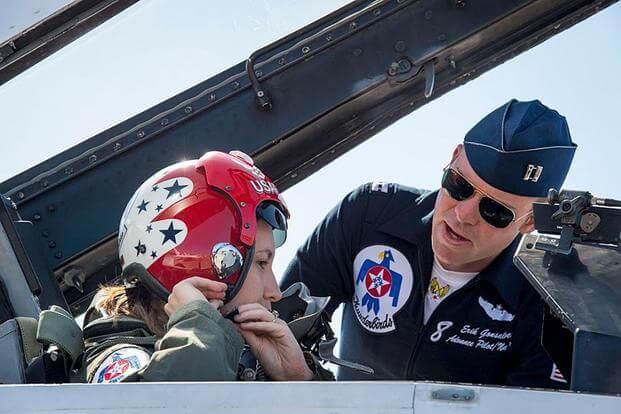A wet runway and wind gusts made an Air Force Thunderbirds F-16 Fighting Falcon slide and flip after landing during a routine training flight, an Air Force accident investigation report found.
Officials said "excess airspeed and insufficient stopping distance" on the runway -- soaked due to inclement weather -- at Dayton International Airport, Ohio, resulted in the two-seater aircraft's crash.
A failure to follow procedures by Thunderbird 8, piloted by Capt. Erik "Speedy" Gonsalves, also contributed to the mishap, the report said.
"Contributing factors to the accident included: environmental conditions affecting vision, misperception of changing environment, and failure to follow procedures," it said.
Related content:
The mishap occurred June 23, 2017, during a "familiarization flight" piloted by Gonsalves and Staff Sgt. Kenneth Cordova, a maintenance crew member, before the Dayton Air Show the following day.
"Upon landing, the pilot was unable to stop the [F-16D] aircraft on the prepared surface. As a result, the aircraft departed the runway and overturned in the grass," the report said.
Both Gonsalves and Cordova sustained injuries. The Thunderbirds' participation in the show was canceled. The aircraft, valued at $29 million, was destroyed.
The report noted Gonsalves missed his first landing approach. The water had blurred his head-up display, known as the HUD, forcing him to rely on cockpit instruments.
During the second approach, Gonsalves -- unable to see properly because of the torrential rain -- focused on the runway more than other factors such as airspeed and distance, it said.
Gonsalves needed a distance of between 7,000 and 8,000 feet to land safely on a wet runway; however, the former A-10 Thunderbolt II pilot misjudged his speed and the needed distance, touching down with only about 6,130 feet left.
An audio recording between air traffic control and Thunderbird 8, Gonsalves' plane, obtained by the Dayton Daily News last month, revealed that the pilot was warned of "extreme precipitation" in the area.
Air traffic control warned Gonsalves he was "flying at your own risk. ... Extreme precipitation over the field."
"Wind shear advisories are in effect," according to the audio.
After the audio's release, Lt. Col. Jason Heard, commander and leading pilot of the Thunderbirds, defended Gonsalves' efforts to recover, given the circumstances.
Gonsalves had "a lot of experience," Heard said, with 1,600 flight hours. "We land in rain all the time."
"From the Thunderbirds that were on scene ... to crash recovery ... to fire department ... it was a tremendous effort. Very impressed and grateful," Heard said.
Air Combat Command, which oversaw the accident investigation, didn't respond to Military.com by press time on Gonsalves' status with the Thunderbirds.
Last year, the Thunderbirds had a mishap after an accidental throttle rotation led to a malfunction and subsequent engine stall that caused the No. 6 jet to crash.
It happened after a flyover of the U.S. Air Force Academy graduation on June 2, 2016, attended by then-President Barack Obama.











